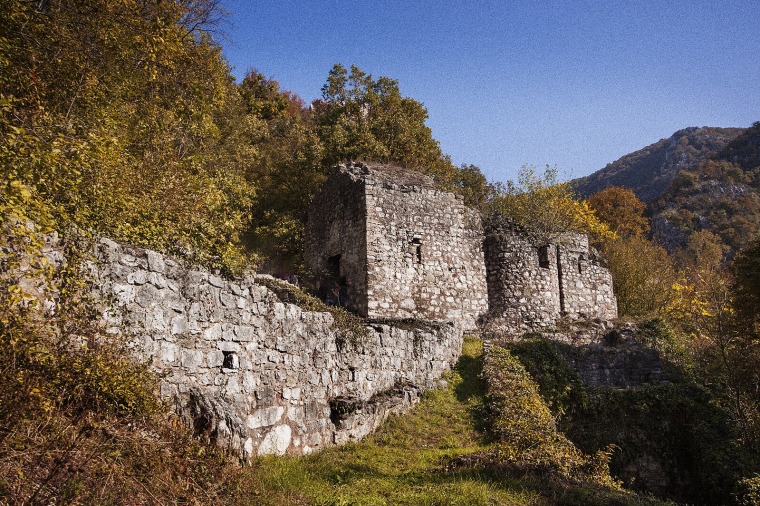Lepenski Vir, a Paleolithic site on the banks of the Danube, is a proof that the local culture developed social relations, architecture and art more than six thousand years ago.

Cultural center of prehistoric world was right here in what today is Serbia. The culture of Lepenski Vir is around 8,5 millennia old and it is a cradle of archaeological discoveries that have changed our knowledge about the early Stone Age in Europe.
Lepenski Vir is one of the largest and most significant prehistoric archeological sites from the Stone Age.
It is located on the right bank of the Danube in the Djerdap gorge (The Iron gates of the Danube) near the town of Donji Milanovac.
It was the center of one of the most complex prehistoric cultures.
Rich cultural layer reveals the traces of highly developed culture that had complex social relations and as such was the first in Europe to organize its settlement according to a plan.
The discovery of this prehistoric settlement that was named after a vortex in the Danube has changed the image we had about the early Stone Age, expanding our knowledge about how developed human communities that walked the Earth 8,500 ago were.
During the archaeological excavations seven stages in the construction of the settlement and 136 buildings were discovered. The settlement was built on the loessial terraces facing the Danube, the river that gave them life and at the same time seemed divine and awe-inspiring.
During the archaeological excavations the contours of settlement built according to a plan were discovered, making it the first discovered urban settlement in Europe.
The characteristic of this settlement were the trapezoid-base houses with primitive wooden construction which were organized in the shape of a horseshoe. The buildings surrounded an open space – the first known square, with the central building, probably some kind of a temple or a shrine. Fireplace surrounded with fishlike stone figurines took central place in every house.
The culture of Lepenski Vir flourished along the Danube and the Đerdap gorge on several locations, and it was named after the largest and the most significant site, Lepenski Vir.
The presence of the river and the significance that it had in lives of these people can be seen in the symbol of this site, monumental fishlike creatures made of the Danube pebbles.
Stone idols found in Lepenski Vir represent the oldest monumental stone sculptures found in Europe. At first they only had a head with a strange expression, while in later stages these figurines had anthropomorphic shapes.
Besides these figurines numerous tools and arms made of stone, bone and antler, pottery and jewelry made of shells and pebbles were found here. Based on these evidence we can conclude that these first inhabitants of the Danube banks lived at the time of the so called Neolithic revolution, when the first communities started working the land and tamed some animals.
The culture of Lepenski Vir developed in the period from 6,500 to 5,500 BC. Today this archaeological site represents unique cultural and historical site within the Đerdap National Park.
After the dam on the Danube was built for the hydro power plant “Đerdap I”, the settlement was relocated on a higher level in order not to be flooded.
This site also includes the Museum with the most significant archaeological findings with additional exhibition and virtual reconstruction of the settlement. This site is protected as a nature reserve.
How to get to this Paleolithic site?
You can reach Lepnski Vir by car, bus, boat and bicycle.
If you go by car, it is best to take the Belgrade-Kladovo highway and you need to cross around 170km. From Niš it is best to go over the Tresibaba mountain pass, then Knjaževac, Zaječar, Negotin and Kladovo. This road coincides with the bicycle route – Eurovelo 6, so you can reach this site and the important cycling area of Serbia by your bicycle as well.
From Belgrade to Donji Milanovac the buses are frequent and Donji Milanovac is 15km from the site.
If you are a river admirer, then taking a boat to Lepenski Vir is the best way to visit this cultural pearl. There are also organized sailing tours from Belgrade.
When you are already here, don’t miss…
Walking around Djerdap National Park and seeing the fantastic Djerdap gorge.
When you find yourself in this region, you should know that you are on the roads of the Roman emperors, as once this was a part of the Roman Empire.
The Roman emperors left numerous structures that you should see if you are here: Tabula Traiana and the remains of Trajan’s Bridge in the vicinity of Kladovo, Diana Fortress from the 1st century; the antique complex of palaces and temples of the Roman emperor Galerius – the archaeological site Felix Romuliana near the city of Zaječar.
The remains of an ancient Roman city and military camp Viminacium are located near Smederevo.
Don’t miss seeing the medieval forts on the Danube: Smederevo, Golubac and Fetislam (near Kladovo).
This region is rich with vineyards, and there’s the famous Negotin wine route to be visited. Don’t miss tasting wine in the unique wine cellars created in the second half of the 18th century – Rajac, Rogalj, Štub and Smedovac pimnice (a kind of old wine cellar).
Visit Rajko’s cave, one of the most beautiful in Serbia, about 2.5km from the centre of Majdanpek.















